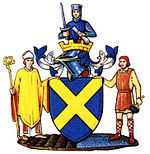St Albans City Council
Coordinates: 51°45′07″N 0°20′10″W / 51.752°N 0.336°W
| St Albans City Council St Albans City and District Council | |
|---|---|
 | |
| Type | |
| Type |
Non-metropolitan district council of the City of St Albans |
| Leadership | |
Mayor of St Albans |
Geoff Harrison |
Executive Leader |
Julian Daly, Con. |
| Seats | 58 |
| Elections | |
| Plurality voting system | |
Last election | 22 May 2014 |
| Meeting place | |
| Civic Centre, St Peters Street, St Albans | |
| Website | |
| http://www.stalbans.gov.uk/ | |
St Albans City Council, also known as St Albans City and District Council, is the local authority for the St Albans non-metropolitan district of England, the United Kingdom. St Albans is located to the west of Hertfordshire, in the East of England region. The council itself is based in St Albans, the largest settlement in the district.
The council consists of 58 elected members, representing twenty electoral wards. 18 of the wards elect three councillors each. Two elect only two. The council currently has no overall control.
Composition
As of the 2014 election the composition of the council is as follows:-[1]
| Party | Councillors | |
|---|---|---|
| Conservative | 29 | |
| Liberal Democrat | 19 | |
| Labour | 8 | |
| Green | 1 | |
| Independent | 1 | |
| Total | 58 | |
Wards
St Albans consists of twenty wards. Wards electing two members are denoted with an obelisk (†). The rest elect three members.
|
|
|
|
Electoral history
Elections to the council are held in three out of every four years, with one third of the 58 seats on the council being elected at each election. Since the first election to the council in 1973 the Conservative party and the Liberal Democrats have had periods in control of the council.[1]
The Conservatives had a majority from 1973 to 1984 and then again from 1998 to 1991 after a period where no party had a majority. The Liberal Democrats won control in 1994, but lost their majority at the 1999 election, although they would have further periods with a majority from 2006 to 2007 and from 2008 to 2011.[1] Since the 2011 election the Conservatives have had exactly half the seats on the council with 29 councillors.[1][2]
Mayoralty
St Albans has had a Mayor since the first Charter in 1553 (over 450 years). The first Mayor was a man called John Lockey. Some Mayors have served for less than a year for a variety of reasons such as changes in local government arrangements, the outbreak of war or if they died in office. Other Mayors have served twice or even for three successive years as one mid-Victorian Mayor managed to do.
The Charter also appointed 10 other men (Principal Burgesses) to assist the Mayor in running the City. The Mayor had both Executive and Judicial Roles. They were not elected democratically but were nominated for life by friends and contacts of the other existing Burgesses. The executive structure is similar to the situation today where we have an Executive Cabinet of 8 Senior Members, although the Cabinet and indeed all 58 Councillors are elected for 4 year terms. The Mayor's role is no longer Executive or Legal. It is ceremonial and is to represent the City and District Council locally, nationally and indeed internationally at important events.
A list of the past Mayors of St Albans is available on the St Albans City and District Council Website: http://www.stalbans.gov.uk/Images/MayoralCount_tcm15-34883.pdf
References
- ↑ 1.0 1.1 1.2 1.3 "St Albans". BBC News Online. Retrieved 3 February 2015.
- ↑ "England council elections". BBC News Online. 10 May 2011. Retrieved 3 February 2015.
External links
| ||||||||||